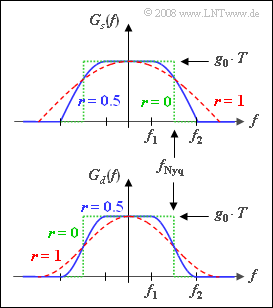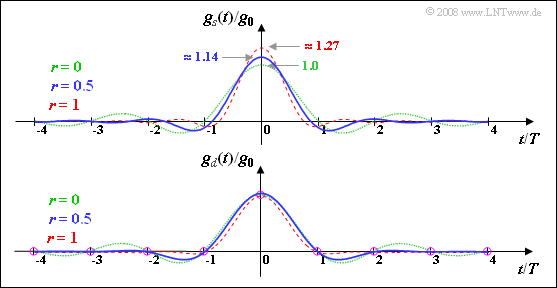Difference between revisions of "Aufgaben:Exercise 4.12: Root-Nyquist Systems"
| Line 7: | Line 7: | ||
*In this case, the basic detection pulse $g_d(t)$ satisfies the [[Digital_Signal_Transmission/Properties_of_Nyquist_Systems#First_Nyquist_criterion_in_the_time_domain|first Nyquist criterion]], since $G_d(f)$ is point-symmetric about the so-called "Nyquist frequency" $f_{\rm Nyq} = 1/T$ . | *In this case, the basic detection pulse $g_d(t)$ satisfies the [[Digital_Signal_Transmission/Properties_of_Nyquist_Systems#First_Nyquist_criterion_in_the_time_domain|first Nyquist criterion]], since $G_d(f)$ is point-symmetric about the so-called "Nyquist frequency" $f_{\rm Nyq} = 1/T$ . | ||
| − | *$G_d(f)$ is a [[Linear_and_Time_Invariant_Systems/Some_Low-Pass_Functions_in_Systems_Theory# | + | *$G_d(f)$ is a [[Linear_and_Time_Invariant_Systems/Some_Low-Pass_Functions_in_Systems_Theory#Raised-cosine_low-pass_filter|cosine rolloff spectrum]], where the rolloff factor $r$ can take values from $0$ to $1$ (including these limits). |
Revision as of 13:06, 19 April 2022
In "quadrature amplitude modulation" $\rm (QAM)$ systems, the "root-Nyquist variant" is often chosen (which gets its name from the spectral range) instead of a rectangular basic transmission pulse. The reason for this is the significantly smaller bandwidth.
- In this case, the basic detection pulse $g_d(t)$ satisfies the first Nyquist criterion, since $G_d(f)$ is point-symmetric about the so-called "Nyquist frequency" $f_{\rm Nyq} = 1/T$ .
- $G_d(f)$ is a cosine rolloff spectrum, where the rolloff factor $r$ can take values from $0$ to $1$ (including these limits).
Furthermore, the following holds for the Nyquist frequency response:
- When $|f| < f_1 = f_{\rm Nyq} · (1 – r)$ ⇒ $G_d(f)$ is constant and equal to $g_0 · T$.
- At frequencies greater than $f_2 = f_{\rm Nyq} · (1 + r)$ ⇒ $G_d(f)$ has no components.
- In between, the slope is cosine.
The optimization of digital communication systems requires that the receiver frequency response $H_{\rm E}(f)$ should be of the same shape as the transmission spectrum $G_s(f)$ .
To obtain dimensionally correct spectral functions for this task and the graph, it is assumed that
- $$G_s(f) = \sqrt{g_0 \cdot T \cdot G_d(f)},$$
- $$ H_{\rm E}(f) = \frac{1}{g_0 \cdot T}\cdot G_s(f)\hspace{0.05cm}.$$
The top graph shows the transmission spectrum $G_s(f)$ for the rolloff factors
- $r = 0$ (green dotted rectangle),
- $r = 0.5$ (blue solid curve),
- $r = 1$ (red dashed curve).
Below, the spectrum $G_d(f)$ of the basic detection pulse before the decider is shown in the same colors.
- The associated pulse $g_d(t)$ is a Nyquist pulse for all valid rolloff factors $(0 ≤ r ≤ 1)$ as opposed to the basic transmission pulse $g_s(t)$.
- For this, the following equation is given in the literature - for example in [Kam04] :
- $$g_s(t) = g_0 \cdot \frac{4 r t/T \cdot \cos \left [\pi \cdot (1+r) \cdot t/T \right ]+ \sin \left [\pi \cdot (1-r) \cdot t/T \right ]}{\left [1- (4 r t/T)^2 \right ] \cdot \pi \cdot t/T}\hspace{0.05cm}.$$
Hints:
- This exercise belongs to the chapter "Quadrature Amplitude Modulation".
- Particular reference is made to the page "Nyquist and Root-Nyquist systems" in this chapter.
- Further useful informations can be found in the chapter Properties of Nyquist Systems in the book "Digital Signal Transmission".
- [Kam04] refers to the textbook "Kammeyer, K.D.: Nachrichtenübertragung. Stuttgart: B.G. Teubner, 4. Auflage, 2004".
- Energies are to be specified in $\rm V^2s$; they thus refer to the reference resistance $R = 1 \ \rm \Omega$.
Questions
Solution
- $$g_s(t) = g_0 \cdot \frac{\sin \left (\pi \cdot t/T \right )}{\pi \cdot t/T} = g_0 \cdot {\rm sinc} \left ( {t}/{T} \right )\hspace{0.05cm}.$$
- At time $t = 0$, ${\rm sinc} \left ( {t}/{T} \right ) =g_0$:
- $$ g_s(t) \hspace{0.15cm}\underline { = 1.0 } \cdot g_0 \hspace{0.05cm}.$$
(2) When $r = 1$, the given equation simplies as follows:
- $$g_s(t) = \frac{4 \cdot g_0}{\pi} \cdot \frac{ \cos \left (2 \pi \cdot t/T \right )}{\left [1- (4 t/T)^2 \right ] }\hspace{0.3cm}\Rightarrow \hspace{0.3cm} g_s(t = 0) = \frac{4 \cdot g_0}{\pi} \hspace{0.15cm}\underline {= 1.273 }\cdot g_0 \hspace{0.05cm}.$$
(3) The last answer is correct:
- Zero intercepts are only possible for $r = 1$ if the cosine function in the numerator is zero, that is, for all integer values of $k$:
- $$2 \pi \cdot t/T = {\pi}/{2} + k \cdot \pi \hspace{0.3cm}\Rightarrow \hspace{0.3cm} t = \pm 0.25T, \hspace{0.15cm} \pm 0.75T, \hspace{0.15cm}\pm 1.25T, \hspace{0.15cm} ...$$
- However, only the last answer is correct, since the zero values at $±0.25T$ are cancelled by the zero in the denominator.
- Applying de l'Hospital's rule yields $g_s(t = ± 0.25T) = g_0$.
(4) With $r = 0.5$ and the shortcut $x = t/T$, one gets:
- $$g_s(x) = \frac{g_0}{\pi} \cdot \frac{2 \cdot x \cdot \cos \left (1.5\pi \cdot x \right )+ \sin \left (0.5\pi \cdot x \right )}{\left (1- 4 \cdot x^2 \right ) \cdot x}\hspace{0.05cm}.$$
- For the calculation at time $t = 0$, de l'Hospital's rule must be applied.
- The derivatives of the numerator and denominator give:
- $$Z'(x) = 2 \cdot \cos \left (1.5\pi \cdot x \right ) - 3 \pi \cdot x \cdot \sin \left (1.5\pi \cdot x \right ) + 0.5 \pi \cdot \cos \left (0.5\pi \cdot x \right ),$$
- $$N'(x) = \left (1- 4 \cdot x^2 \right ) - 8 \cdot x^2 \hspace{0.05cm}.$$
- The two boundary transitions for $x → 0$ yield:
- $$\lim_{x \rightarrow 0} Z'(x) = 2 +{\pi }/{2},\hspace{0.2cm} \lim_{x \rightarrow 0} N'(x) = 1 \hspace{0.05cm}.$$
- Thus, for the signal amplitude at time $t = 0$:
- $$g_s(t=0) = \frac{g_0}{\pi} \cdot \left ( 2 +{\pi }/{2} \right ) = {g_0} \cdot \left ( 0.5 + {2}/{\pi } \right )\hspace{0.15cm}\underline {= 1.137} \cdot g_0 \hspace{0.05cm}.$$
Here, the graph illustrates the results calculated again:
- $g_d(t)$ is a Nyquist pulse, meaning that it has zero crossings at least at all multiples of the symbol duration $T$ (and possibly others depending on the rolloff factor).
- On the other hand, the pulse $g_s(t)$ does not satisfy the Nyquist criterion. Moreover, from this plot one can once again see that for $r ≠ 0$ the pulse amplitude $g_s(t = 0)$ is always larger than $g_0$.
(5) The last answer is correct $($the first answer is ruled out from the results in questions (2) and (4) $)$. The validity of the lower bound $g_0$ and the upper bound $4g_0/π$ can be proved as follows:
- The pulse amplitude $g_s(t = 0)$ is generally equal to the area under the spectral function $G_s(f)$.
- The smallest area is obtained for $r = 0$. Here, $G_s(f) = g_0 · T$ is in the range $|f| < ±1/(2T)$. Thus, the area is equal to $g_0$.
- The largest area is obtained for $r = 1$. Here, $G_s(f)$ extends to the range $±1/T$ and has a cosine shape.
- The result $g_s(t = 0) = 4g_0/π$ was already calculated in question (3) . Though it still holds that:
- $$g_s(t=0) = 2 \cdot {g_0} \cdot \int_{ 0 }^{1/T} {\cos\left(\frac{\pi }{2}\cdot f \cdot T \right)}\hspace{0.1cm} {\rm d}f = \frac{4 g_0}{\pi} \cdot \int_{ 0 }^{\pi/2} {\cos\left(x \right)}\hspace{0.1cm} {\rm d}x = {4 g_0}/{\pi} \cdot \big[\sin(\pi/2) - \sin(0) \big] = {4 g_0}/{\pi}\hspace{0.05cm}.$$
(6) The energy of the basic transmission pulse $g_s(t)$ can be found in the time or frequency domain according to Parseval's theorem:
- $$E_{g_s} = \int_{ -\infty }^{+\infty} {[g_s(t)]^2}\hspace{0.1cm} {\rm d}t = \int_{ -\infty }^{+\infty} {|G_s(f)|^2}\hspace{0.1cm} {\rm d}f \hspace{0.05cm}.$$
- From the equations and graph on the exercise page, we can see that $|G_s(f)|^2$ has the same shape as $G_d(f)$, but the height is now $(g_0 · T)^2$ instead of $g_0 · T$:
- $$E_{g_s} = \int_{ -\infty }^{+\infty} {|G_s(f)|^2}\hspace{0.1cm} {\rm d}f = \frac{g_0^2 \cdot T^2}{g_0 \cdot T} \cdot \int_{ -\infty }^{+\infty} {G_d(f)}\hspace{0.1cm} {\rm d}f \hspace{0.05cm}.$$
- Due to the Nyquist form of $G_d(f)$, it holds independently of $r$:
- $$\int_{ -\infty }^{+\infty} {G_d(f)}\hspace{0.1cm} {\rm d}f = g_0 \hspace{0.05cm}.$$
- Thus, the pulse energy is also independent of $r$, so it is also valid for $r = 0$ and $r = 1$. In both cases, $E_ {g_s}\hspace{0.15cm}\underline { = 1.0} · g_0^2 · T.$

